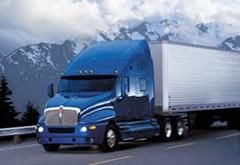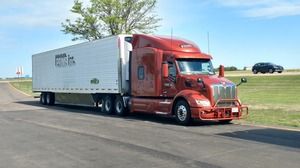Trip Planning/Driving Time
Topic 10552 | Page 2

Go go technology! Give me ALL the gadgets!! 
You can have all the gadgets but do make sure you have a truckers road atlas and become proficient with it. The atlas will never get you lost, gps still can and will.

Truth. I actually miss the days of having a road atlas when going on long trips. I loved planning the route and choosing which roads to take based on where I wanted to do some sightseeing. I do intend to get an atlas specifically for the trucking industry, probably more than one (if more than one is published). Although, it never is fun when a road you're on isn't on the map. Had that happen a few times.
OOS:
When a violation by either a driver or company is confirmed, an out-of-service order removes either the driver or the vehicle from the roadway until the violation is corrected.
Miss Miyoshi is searching for The Way:
I do intend to get an atlas specifically for the trucking industry, probably more than one (if more than one is published)
Yes, there's many more than one available. The Bible for trucking atlases is the Rand McNally Motor Carriers Road Atlas. Get the Deluxe one, with laminated pages. That's where you use the wipe off markers I recommended. Truck stops usually have the best prices for these. (I never imagined I'd write a sentence that says truck stops have the best prices!)

Hahahaha! Thanks for the heads up. I've added that to my list of things to acquire.

Elogs vs. paper, elogs only required that you update your status as any that I have used might take you to the ON DUTY line when you shut off the engine, but YOU need to log OFF DUTY or SLEEPER yourself, and inevitably folks will forget. Paper, as I have used for the past year, requires that you keep yourself straight at all times, though you can program some things in there as needed if necessary though not recommended. For trip planning on elogs, always be sure that you have planned somewhere to get that 30 min in before your 8 hrs are up or you're uber-screwed with HOS violation, and again before your 11/14 is up for same reason. Also with elog , you will be entering your load info into the computer along with any macros that your company requires, like load weight (from BOL) start times, end times, seal #s, etc. Lots of info goes into that. I use a calculator to plan for the trip. Total miles divided by 45 mph for total travel time, then break it into blocks according to your needs. I've had dispatchers try to tell me to plan for 60 mph. Not correct, because your routes will be planned efficiently and take you through towns and such, so plan for 45 mph so that you have safely planned for any stops and traffic and food and restrooms, etc. That is what is taught to trainers, anyway. If anything, you will be more safe that way and have enough cushion time to get there without stressing yourself out.
Elog:
Electronic Onboard Recorder
Electronic Logbook
A device which records the amount of time a vehicle has been driven. If the vehicle is not being driven, the operator will manually input whether or not he/she is on duty or not.
Elogs:
Electronic Onboard Recorder
Electronic Logbook
A device which records the amount of time a vehicle has been driven. If the vehicle is not being driven, the operator will manually input whether or not he/she is on duty or not.
Dispatcher:
Dispatcher, Fleet Manager, Driver Manager
The primary person a driver communicates with at his/her company. A dispatcher can play many roles, depending on the company's structure. Dispatchers may assign freight, file requests for home time, relay messages between the driver and management, inform customer service of any delays, change appointment times, and report information to the load planners.HOS:
Hours Of Service
HOS refers to the logbook hours of service regulations.
Not correct, because your routes will be planned efficiently and take you through towns and such, so plan for 45 mph so that you have safely planned for any stops and traffic and food and restrooms, etc. That is what is taught to trainers, anyway. If anything, you will be more safe that way and have enough cushion time to get there without stressing yourself out.
I personally like to plan using 50 MPH. The reason is that it is way easier than 45 and you can do it in your head in case you need to change your route for whatever the reason. Most places today setup the pickup/delivery times to accommodate enough time to allow for things such as traffic, weather, etc. If you plan for 50 and are able to maintain 55 - 58 +, then you already have time built into your schedule for the unexpected. Just my thoughts on this.
Ernie
I've been using 50 mph for planning and it seems to be pretty accurate. Our trucks are governed at 63; sometimes I can go that fast, other times I will be stuck in a construction zone, slowed down by traffic, etc, and the 50 mph is a good average to work with. Also, like Ernie said, easy math to recalculate in my head while driving.

A full 50% of what Dustan wrote sounded a little like Greek to me, as I'm not yet driving and have no idea what half of those items are that you discussed. Hahahaha! But, I'm going through the vocabulary list on here, and trying to match those with google images or more web research to explain what exactly these things are. I'll get it one day!
And I was also thinking calculating to 50mph would be a good target for the reasons you stated.
HOS:
Hours Of Service
HOS refers to the logbook hours of service regulations.New Reply:
New! Check out our help videos for a better understanding of our forum features

















Preview:
This topic has the following tags:
Advice For New Truck Drivers Electronic Logbooks Time Management Trip Planning







 TT On Facebook
TT On Facebook
By next year, everything will be electronic logs and by 2017, owner operators will have to run e logs as well.
Electronic Logs:
Electronic Onboard Recorder
Electronic Logbook
A device which records the amount of time a vehicle has been driven. If the vehicle is not being driven, the operator will manually input whether or not he/she is on duty or not.
Owner Operator:
An owner-operator is a driver who either owns or leases the truck they are driving. A self-employed driver.